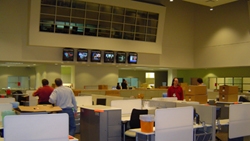Omneon Video Networks VP Product Management foresees automation woes at 60 frames per second

WCPO-TV in Cincinnati, Ohio, has installed two Omneon SPECTRUM media server systems to create a unique digital workflow for production and playout.
Concluding the interview with Omneon Video Network’s VP Product Management Paul Turner, High Definition Technology Update’s conversation turned to a new wrinkle in HD implementation at television stations: 720p at 60 frames per second.
Turner said he foresees the 60fps standard forcing automation system manufacturers to rethink how the duration of commercials, programs and promos is counted.
HDTU: As the transition to digital picks up momentum at TV stations, can you predict any unanticipated “gotchas’?
Paul Turner: There is a fine point that seems to have bypassed many people at this point. In Europe, HD is 1080i running at 25fps. In the United States, 1080i is 24.97fps – essentially the same thing. In addition, 720p has been adopted at 29.97. However, 720p at 30fps can seem a little too jittery on the home set, even with internal frame doublers. 720p at 60fps is coming.
HDTU: Is that a problem for companies like Omneon?
Turner: That’s a wrinkle for server vendors. We have to double the amount of data we have to get out of the server. But that’s technically achievable. 720p at 60fps is achievable for the broadcast chain as well.
Get the TV Tech Newsletter
The professional video industry's #1 source for news, trends and product and tech information. Sign up below.
HDTU: So what’s the issue?
Turner: The question is how do you control it?
Automation systems are designed around 30fps. The entire time code system is based on 30fps. What happens to the automation system if 60fps are introduced?
Automation system vendors have yet to really consider it. Do they have to this second? No, it’s not fully ratified yet, but it is something the industry must consider.
Does the advent of the 60fps standard mean that we need to completely rethink time code? Do you treat frames as if they were fields so you don’t have to change the math much? What does it do in terms of duration? Most automation systems calculate time based on frames not fields.
HDTU: And the difference between field and frame-based time calculation will manifest itself every time a new on-air element is transmitted?
Turner: You may be OK for a one off. But if every element is off by a field period, over time you are going to drift off your schedule.
I only raise the flag because one of our engineers asked me, “How’s it going to be controlled?” That caused me to do a quick survey of the automation vendors, to understand their position. I found that few, if any, had considered the issue.
It is going to be an issue for automation partners. Most agree that you can’t have time code above 30 frames - that will definitely break something.
This is not an insurmountable issue, but it is something we must consider in the transition to HD.
For more information, read Part 1 and Part 2 of HDTU's interviews with Turner.
Tell us what you think!
HDTU invites response from our readers. Please submit your comments to editor@broadcastengineering.com. We’ll follow up with your comments in an upcoming issue.
